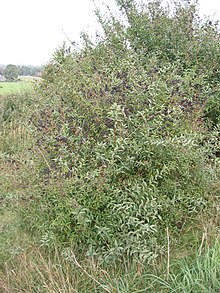Privet
- This article is about the privet plant in the genus Ligustrum. "Privet" may also refer to plants in two other genera in family Oleaceae: Forestiera ("Swamp-privet") and Phillyrea ("Mock-privet"). Also, in Russian "privet" means "hello"

Privet was originally the name for the European semi-evergreen shrub Ligustrum vulgare, and later also for the more reliably evergreen Ligustrum ovalifolium (Japanese privet), used extensively for privacy hedging. It is often suggested that the name privet is related to private, but the OED states that there is no evidence to support this.[1] Some forensic ligua-horticuluralists posit that the common name for privet is related to the Slavic salutation common Russian phrases as the plant is often found to the side of unpaved roads.[citation needed] The term is now used for all members of the genus Ligustrum, which includes about 40-50 species of evergreen, semi-evergreen or deciduous shrubs and small trees, native to Europe, north Africa, Asia and Australasia, with the centre of diversity in China, the Himalayas, Japan and Taiwan. The generic name originated in Latin and was applied by Pliny the Elder (23 CE – 79) to L. vulgare.[2] The genus is placed in the olive family, Oleaceae.
The flowers are small and fragrant and borne in panicles. They have four curled-back petals and two high stamens with yellow or red anthers, between which is the low pistil; the petals and stamens fall off after the flower is fertilized, leaving the pistil in the calyx tube. Flowering starts after 330 growing degree days. The fruits, borne in clusters, are small purple to black drupes. The fruits of some species are mildly poisonous to humans.[3]
Ecology
In favorable growing conditions, individual shrubs may produce thousands of fruits, most of which are eaten by birds.
The Privet is used as a food plant by the larvae of some Lepidoptera species including Common Emerald, Common Marbled Carpet, Copper Underwing, the Engrailed, Mottled Beauty, Scalloped Hazel, Small Angle Shades, The V-pug and Willow Beauty.
Problems
Privet is one of several plants that are poisonous to horses. In some parts of the world where they are not native, some privet species have become invasive weeds, spreading into wilderness areas and displacing native species. This is particularly a problem in North America, where no species of the genus occurs naturally. Privet is poisonous to most pets. [4] Privet is also a huge problem in New Zealand and the east coast of Australia. It is banned from sale or cultivation in New Zealand because its pollen is known to cause asthma and eczema in sufferers. Privet can be removed by contacting local government agencies to report its presence.[5]
References
- ^ Oxford English Dictionary. privet, n.1 http://dictionary.oed.com/cgi/entry/50188940
- ^ Foster, Steven (2008). National Geographic Desk Reference to Nature's Medicine. National Geographic Books. p. 116. ISBN 978-1-4262-0293-3.
{{cite book}}: Unknown parameter|coauthors=ignored (|author=suggested) (help) - ^ Plants for a Future, http://www.pfaf.org/database/plants.php?Ligustrum+japonicum
- ^ Swearingen, Jil; Reshetiloff, K.; Slattery, B; Zwicker, S. (2010). Plant Invaders of Mid-Atlantic Natural Areas, 4th Edition (PDF). National Park Service and U.S. Fish & Wildlife Service. p. 71. This reference lists L. vulgare, L. obtusifolium, L. ovalifolium, and L. sinense as invasive.
- ^ "Environment Waikato on Privet".
